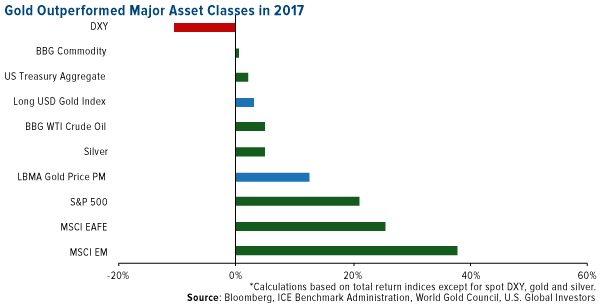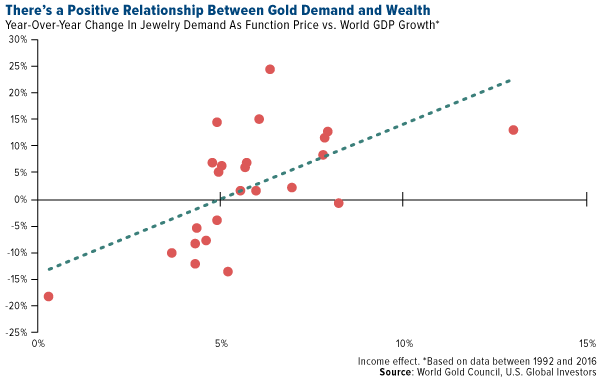
In a year when the S&P 500 hit all-time highs, gold also held strong, finishing 2017 up 13.5 percent, according to the World Gold Council. Gold’s annual gain was the largest since 2010, outperforming all major asset classes other than stocks. Contributing to this gain was a weaker U.S. dollar, stock indices hitting new highs and geopolitical instability, all of which fueled uncertainty. Investors continued to add gold to their portfolios to manage risk exposure, with gold-backed ETFs seeing $8.2 billion of inflows last year.

The World Gold Council (WGC) recently released its annual outlook on the yellow metal identifying four key market trends it believes will support positive gold performance in 2018, and we agree. Below I summarize the report for you and add some of my own thoughts on gold’s trajectory.
Key Trends Influencing Gold in 2018
1. A year of synchronized global economic growth
Economies are on the rise with global growth increasing in 2017 and on track to continue the trend this year. China and India, two of the world’s largest consumers of gold, will see their economies and incomes grow due to the implementation of new economic policies. WGC research shows that as incomes rise, the demand for gold jewelry and gold-containing technology tends to rise as well. Investment and consumer demand for the yellow metal results in a lower correlation to other mainstream financial assets, such as stocks, making it an effective portfolio diversifier.

2. Shrinking balance sheets and rising interest rates
Expectations are for the Federal Reserve to raise interest rates three times this year and shrink its balance sheet by allowing $50 billion in Treasuries and mortgage-backed securities to mature each month. Over the past decade, central banks pumped trillions into the global economy and cut interest rates, allowing asset values to break records and market volatility to reach record lows.
With these banks reining in expansionary policies in 2018 and hiking rates as global debt increases, market volatility may go up again, making gold a more attractive asset. According to WGC research, when real rates are between zero and 4 percent, gold’s returns are positive and its volatility and correlation with other mainstream financial assets are below long-run averages.













Leave A Comment